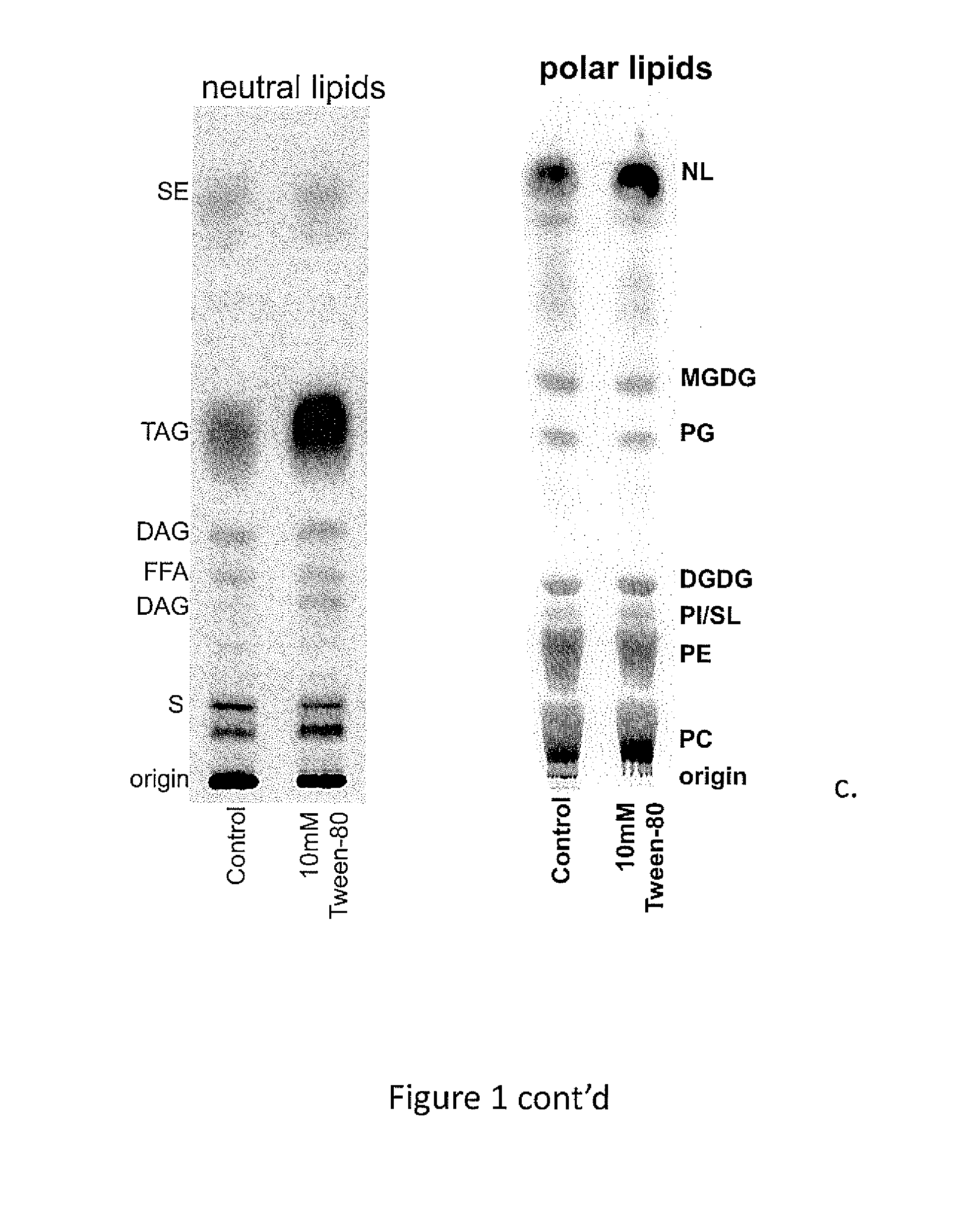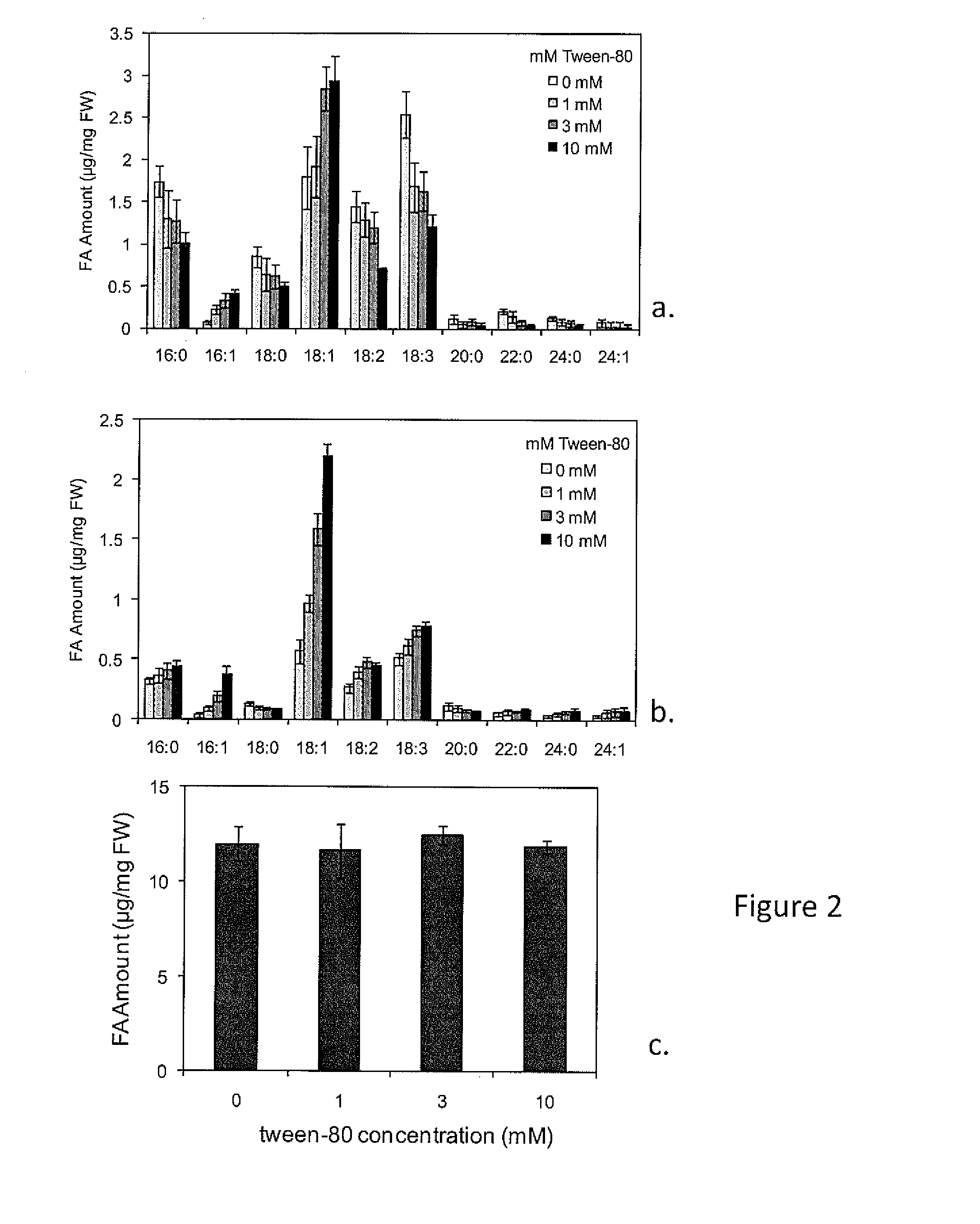Modified plants with increased oil content
a technology of modified plants and oil content, applied in the field of agronomy, can solve the problems of limiting the oil synthesis of plants, restricting the flux through an entire pathway, and acid biosynthesis, and achieve the effect of increasing the oil content of plant cells
- Summary
- Abstract
- Description
- Claims
- Application Information
AI Technical Summary
Benefits of technology
Problems solved by technology
Method used
Image
Examples
example 1
Experimental Procedures
Cell Culture Growth and Analysis
[0242]Brassica napus cv Jet Neuf suspension cell cultures were grown in NLN medium (Lichter 1982, Z. Pflanzenphysiol, 105, 427-434) with modifications (Shi et al. 2008, Plant Cell Tiss Org, 92 131-139). Cells were grown shaking at 160 rpm at 25° C. in either 50 mL or 100 mL volumes (in 125 mL or 250 mL flasks, respectively) under constant fluorescent light at 50 μmol m−1 s−1. Medium was refreshed every 48 h for experiments lasting longer than two days. Tween-esters were obtained from Sigma (St. Louis, Mo. USA). A 150 mM stock solution was made by dissolving 9.8 g in 50 mL of water and it was filter sterilized before addition to cultures. Subculturing was done every eight days and new cultures were inoculated with about 200 mg of cells. Cells were harvested by filtering with a Buchner funnel, were rinsed three times with distilled water, and were frozen immediately in liquid N2 in preweighed aluminum foil pouches. Dry weight to f...
example 2
Establishing Conditions for Fatty Acid Feeding to B. napus Suspension Cells
[0250]In order to study the feedback regulation of fatty acid synthesis it was necessary to first establish conditions where fatty acids could be fed while minimizing any negative pleiotropic effects. Commercial Tween-80, containing predominately oleic acid (18:1), had no effect on growth rate when added at concentrations up to 10 mM (FIG. 1a). Protein composition of the cells, which was very similar to that of a developing embryo, appeared unaffected after eight days of Tween-80 feeding (FIG. 1b). Water content of the cells was also unaffected; the fresh weight to dry weight ratio being 16.2±0.4 for control and 16.0±0.5 for cells fed 10 mM Tween:-80. As reported for soybean cell cultures (Terzaghi 1986, Plant Physiol, 82, 771-779), the fatty acid composition of B. napus cells was altered by Tween-80. Polar lipids and TAG from cells fed Tween-80 for eight days were quantified and the results are shown in FIG....
example 3
Plastidic ACCase is Reversibly Inhibited in Response to Tween-80
[0252]Feedback inhibition of fatty acid synthesis was measured by the addition of a 14C-acetate tracer. FIG. 4a shows that, indeed, the rate of 14C-acetate incorporation into lipids is reduced by 40% as soon as three hours after the addition of 10 mM Tween-80 to the medium. Sterol synthesis is dependent on acetyl-CoA and ATP, both of which are required for fatty acid synthesis. Therefore, if fatty acid synthesis is inhibited due to substrate limitation; so should be sterol biosynthesis. 14C-acetate incorporation into sterols was unaffected by Tween-80 feeding, while incorporation into free fatty acids mirrored that of total lipids (FIG. 5), showing that the effect is restricted to fatty acid synthesis. We found that the degree of feedback inhibition was dependent on the concentration of Tween-80 in the medium (FIG. 4b) and was completely reversible after its removal (FIG. 4c). These results are consistent with a biochem...
PUM
| Property | Measurement | Unit |
|---|---|---|
| Fraction | aaaaa | aaaaa |
| Fraction | aaaaa | aaaaa |
| Content | aaaaa | aaaaa |
Abstract
Description
Claims
Application Information
 Login to View More
Login to View More - R&D
- Intellectual Property
- Life Sciences
- Materials
- Tech Scout
- Unparalleled Data Quality
- Higher Quality Content
- 60% Fewer Hallucinations
Browse by: Latest US Patents, China's latest patents, Technical Efficacy Thesaurus, Application Domain, Technology Topic, Popular Technical Reports.
© 2025 PatSnap. All rights reserved.Legal|Privacy policy|Modern Slavery Act Transparency Statement|Sitemap|About US| Contact US: help@patsnap.com



